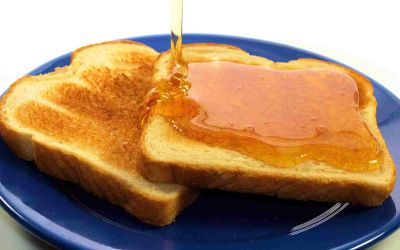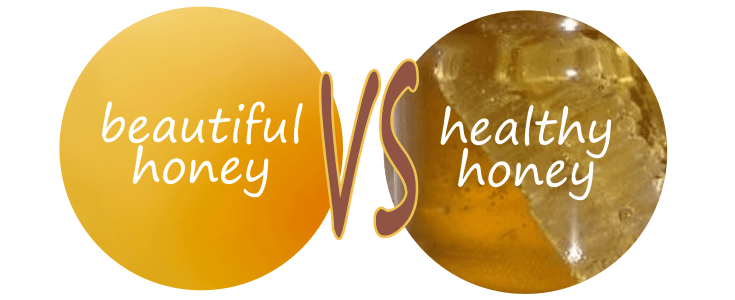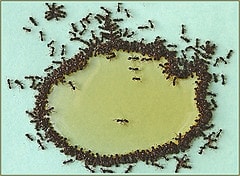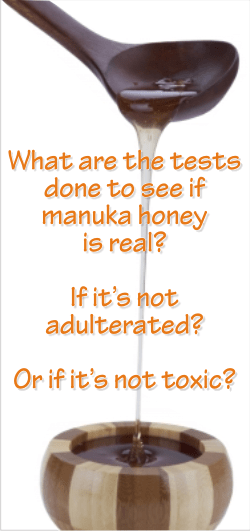There are a few methods to test real honey to see if it was mixed with water or other sugary syrups. None of these methods can tell if honey is organic or not, but they at least tell you if what you bought is only honey or some other substances like flour, starch, chalk, corn syrup, sugar, etc.

1. It should not be very liquid.
If you take the jar from the shelf and turn it upside down, it should form an air bubble the shape of a pear that will go slowly up to the bottom of the jar. If it goes quickly, then it could have been mixed with different substances to increase fluidity and quantity. It can also mean that the honey is not matured, that it has too much water in it due to the fact that it was taken from the combs’ cells too soon, and that it was not dried sufficiently by the bees. (Not their fault, but the beekeepers’.). They wanted to speed the process.) This kind of honey is not as full in nutrients and enzymes as a ripe, mature one.
2. It must crystallize.
To be sure it’s pure honey, the safest way is to buy it already crystallized. Otherwise, depending on the type of flower, honey should crystallize in several months. Some honeys take even longer due to their high content of fructose (see the case of honeydew honeys or some Australian types of honey like yellow box honey). See here some crystallization times.
We should associate the name of the honey with the time of crystallization. If, for example, in winter we have linden honey in a liquid form, it means it is not real.
It can also be really filtrated. This process turns what we call honey into a sugary substance. But to test this in a short time, place the honey in the fridge. If it doesn’t crystallize, it’s not pure.
Further reading: What is artificial honey or fake honey? What we have in our food!
3. It shouldn’t dissolve quickly in water or even in hot tea.
Stir some honey into a glass of water. Pure honey won’t dissolve but rather form a lump and sink down to the bottom of the glass. Impure honey will easily dissolve in the water.
4. It should not perforate or be absorbed by the paper.
Use a blotting paper, coffee filter, or tissue paper. Put some honey on them. If it’s impure honey, the honey will be absorbed by the paper; if it’s pure honey, it will not. It means it doesn’t have any water added.
5. Pure honey is a good skin regimen.
Rub some honey between your index finger and thumb until it disintegrates; it will be absorbed into your skin if there’s honey. Natural honey is not sticky. If what you rub is sticky, it has sugar or artificial sweetener in it.
6. Pure honey doesn’t stain clothes.

If you spilled real honey on your T-shirt, after washing there will be no stain.
7. Honey burns!
Do the test of the matchsticks. Take some matchsticks and stick them with their tips in honey. Wipe off the exceeding honey and strike to light them. If they do, then the honey is good. Fake honey will not light because of the moisture.
You can also use some cotton wicks. Place them in the honey, then keep them above the flame of a candle. Pure honey will burn. Impure honey with a high water content will not.
Or simply hold a lighted match to the honey. If it is natural, it will melt and not begin to hiss immediately.
8. Goes clockwise when poured.
Pour half a cup of honey slowly into another cup. Honey will spin clockwise as you pour it. This is a result of the asymmetrical structure of honey molecules that give it a right hand bias.
 read more about the differences in “pure”, “clear” honey vs raw, healthy honey
read more about the differences in “pure”, “clear” honey vs raw, healthy honey
9. It hardens bread.
Spread it on a slice of bread. Natural honey will harden the bread in minutes. Adulterated and artificial honey will wet the bread because of the water content.
10. Ants don’t disturb natural honey.

Put some honey on a plate outside the house near some ants, and wait. If many ants come, then honey is not pure. If no ants or 2 or 3 that died, the honey is pure. Honey bees instinctively build hives on trees and between rocks. They add an additive to the honey in order to protect it from pests, such as ants.
11. Natural honey caramelizes quickly.
Add 2 to 3 tablespoons to a microwave-proof bowl. Heat on high power until hot. Natural honey will caramelize quickly and never become foamy. Adulterated and artificial honey will become bubbly and difficult to caramelize. Once again, this is because of the water.
12. Long-lasting burning sensation if hot.
Put 2 spoons of honey in a little jar and then place it in a hot water bath. Heat it to 30-600°C (1200°F) and taste it. If it is real honey, you will have a strong sensation in the throat, which will not disappear after 15 minutes!
13. Mature honey wounds on as a tape.
Take some honey with a spoon and quickly turn around its axis. Mature honey with normal humidity should wound on a spoon as a tape. Liquid honey, containing a lot of water, will flow.
14. Test the addition of starch.
Dissolve one part honey in one part water and add 1 drop of standard iodine. If the color of the solution does not change (doesn’t turn blue), then starch syrup is not mixed up. It’s pure. It can also be done with ethanol. In an aqueous solution of honey (1:2) add 96% ethanol and stir. If the solution remains clear, there is starch syrup added.
15. Test the addition of chalk:
Take some honey, dilute it with distilled water, and add a few drops of vinegar. The boiling of the mixture due to the release of carbon dioxide indicates the presence of chalk.
If you mix honey and water and then add 2 or 3 drops of vinegar essence, this mixture should not become foamy. If it does, the honey used was adulterated.
Further reading: What is processed honey?
16. Mix it with an egg yolk and beat with a fork.
If the honey is pure, the yolk will look like it has been cooked.
17. Insert a hot stainless steel wire into it.
Heat a stainless steel piece of wire (a needle can do it) and insert it into the honey. A good honey should stick to the wire and not flow back into the jar.
18. Freeze it
Unadulterated and unprocessed honey should not freeze. This is in fact the best method to preserve the best qualities of honey. Take your fresh jar of honey and place it in the freezer. It will harden, of course, but it will not crystallize nor will it be frozen. You can still take a teaspoon out of it and put it in your tea. It will also guarantee that what you have is real and fresh honey.
19. Mix 1 part honey and 8 parts water, shake well, and check for bubbles.
This is a method of testing real honey received from one of this site’s visitors. I haven’t personally tested it. But CK also sent us a picture to convince us. Thank you, CK.
“I knew a way of testing honey that has become popular recently in some of the Asian countries.
Mix honey with water in a portion of 1 to 8 in a clear bottle; shake it for about 20-30 seconds.
Real honey will form some fine bubbles on the top layer, and it will last for hours.
Fake honey will not have fine bubbles and not last at all.”

_______
If you know any other method to try pure honey, or know that any of the methods listed above don’t work, please leave a comment and let’s shed some light on this theme. 🙂
*********************
References:
matchsticks picture credit: Collin Waldron
Fanica – Voinea Ene, Ghid de terapie naturista, 2006.
naturalnigerian.com
ehow.com
Free picture website

If you need a permanent cure to herpes virus, I am a living testimony…. please contact_____________________________________ [R o b i n s o n b u c kl e r@ ] yahoo (com)…
As a beekeeper with over five years beekeeping experience, i disagree with and fault some of the points. Some of the points do not reflect the result of good research and intelligent enquiry. Permit me to use the more appropriate word “natural honey’
1. To lend a voice to your point, all natural honeys will eventually crystalize. Crystalization is a testimony that the honey is raw, natural and has not been unnecessarily processed. Honey contains fructose and glucose in different proportion (this is dependent on the plant materials the bees get their honey from). When the ratio of glucose is higher, the time for the honey to crystalize will be shorter. Honey rich in pollens(very nutritious substance from plant) will also crystalize faster.
Another factor that speed up crystalization is when the honey is refrigerated. Honey are supposed to be stored under room temperature. The good news however, is that crystalization does not implies that the honey has gone bad but rather that that it is very rich in nutrient and healthy for consumption.
2. Against general belief, honey attracts ants. Ants are generally attracted to sweet substance. However some honey contain insect repellant alkaloid (depending on the flowers the bees get their nectars). Again very viscous honey may not immediately attract ants, but as the honey is exposed to air, it attracts moisture and become more “accessible” to ants.
3. Just as honey will not dissolve easily in water, virtually all substances that are used in adulterating honey has the sane property
4. The match test is based on the principle of moisture content. It is not a reliable test.
Hi Samson,
Thank you for your input.
1. The article says the same. “But to test this in a short time, place the honey in the fridge. If it doesn’t crystallize, it’s not pure.” – which represents a method of testing real honey. Place it in the fridge. If it is real it will crystallize.
Not to confuse this with freezing.
And yes, I agree with 2, 3, 4,too. 🙂
Laura
Another way to test, pour a drop on the sands if it roll its good if not its fake. Though I have not done that myself
I am desperate for a 100% confirmed answer to my question.
All pure honey doesn’t freeze in freezer below 0°C. True or false?
Hi,
First we need to clarify what the term “pure” really means. Please read “what is the difference between pure honey and raw honey“.
Pure means raw, not heated, not pasteurized, or otherwise processed.
Honey as it is harvested by beekeepers DOES NOT freeze. Nor does it crystallize in the freezer. It does harden, but you can still scoop honey with a teaspoon out of the jar, immediately after taking it out of the freezer.
Actually this is the best method to preserve honey’s best properties and still have fresh honey after 6 months of keeping it in the freezer.
Laura
Honey crystallises under refrigeration. The write-ups are not all correct
https://www.quora.com/Does-honey-attract-ants
yes pure can attract ants. also depends on type of ants and the level of sugar, moisture in honey and fructose.
ants eat honey in the wild if a hive has been abandoned.
I have been to beehives and seen ants killing bees and harvesting the honey after bees absconding.
If people want to learn about Australian honey and the quality of Australian honey as well as the bees that are produced for export to the rest of the world please contact the Australian honey bee industry Council or visit their website for more information.
http://honeybee.org.au
The Australian honey bee industry Council represents the beekeeping industry in Australia across all Australian states and territories you can be absolutely issued by the information provided by this industry Council
I read from your article that pure honey will crystallize when put in fridge. That’s also what I know is true. But this one honey seller keeps on insisting that to know pure honey, put it in fridge and if doesn’t crystallize, and if it remains runny, it’s pure. He said he has a bee farm and he knows what he is saying. Now, I’m confused, I want to hear your insight on this. Looking forward to hearing from you soon.
Hi Joy,
Common honeys crystallize in the fridge. It’s a normal process.
There are also honeys with a high content of fructose and these crystallize slower. It’s the case of honeydew honeys, some Australian honeys (Ironbarks or String Bark)or some Florida honeys such as Saw Palmetto or Gallberry honeys.
It depends on their fructose content, the higher it is the longer it will take to crystallize.
Verify what type of honey he sells. And remember that in the fridge the cold accelerates the crystallization process.
More details on crystallization here.
Laura
Many many thanks for your easy and simple explanation about cause of honey crystallization.
Just because a certain variety of honey doesn’t crystallize, doesn’t mean it’s fake. Varieties in Australia such as Yellow Box, some Ironbarks or String Bark can take years to crystallize
Hi KB,
You are right, of course. That paragraph was not clear enough and I have corrected it.
Honeys with a high content of fructose take a longer time to crystallize, I spoke about this in the article about crystallization.
What remains true is that we need to pay attention to the label. Regular European honeys, with the exception of honeydew honeys, should be crystallized over winter.
Anyway, if we place the jar in the fridge, a natural honey should crystallize. And I think this is true for those Australian honeys as well. Please tell me if you know otherwise.
Thank you for your comment.
Laura
I together with my friends have been going through the good guides located on your site and then before long developed an awful suspicion I had not expressed respect to the website owner for those secrets. The young men are actually for this reason passionate to see all of them and have in effect simply been tapping into them. We appreciate you genuinely very kind and for picking out this kind of extraordinary information millions of individuals are really wanting to be aware of. My personal sincere apologies for not expressing gratitude to you earlier.
Great article! My energy levels have always been low so I tried different things to fill in the gaps of nutrition that maybe I was not getting . I tried many many vitamins supplements, but honey in water for a morning drink is the only thing that works. I did notice my organic store honey plops the the bottom and takes a moment to mix with water so that’s a plus.
I just got a hive two months ago, hopefully this time next year I’ll have some backyard fresh honey!
Hi Quinton,
Water and honey in the morning, right? Great choice. A little bit of lemon juice would also complete the taste and add value. 🙂
Good luck with your hives. It’s a wonderful and rewarding job, but not an easy one.
As for the authenticity of honey, I will insert a new one: freezing it. It’s a very good choice for storing fresh honey over the winter, and still maintain the value brought by its freshness.
And we can also check if it’s true. If it freezes it’s adulterated with water. If only gets thicker but you can still scoop it, it’s good.
Laura
Touche. Outstanding arguments. Keep up the amazing effort.
I knew a way of testing honey which is become popular recently in some of the Asia countries.
Mix honey with water in a portion of 1 to 8 in a clear bottle, shake it about 20-30 seconds.
Real honey will form some fine bubbles on top layer and it will last for hours.
Fake honey will not have fine bubbles and not lasting at all.
Hope this helps…
I does help, of course. Thank you very much. I copied your method into the article so it is more visible for everyone. Thanks again.
Laura
Hi Laura,
I tried this method for many times, so far it really works.
For those mixture of certain percentage of real and fake honey,
personally think that the best way is still send the honey for lab C4 sugar testing.
I attached the photo link from internet to show the result of the bubbles test.
http://fooding.hmgcdn.com/images/article/100530/a100530_102116_1385711048.JPG
I learned a lot from this information. When I was an apply farmer, we had bees and sold (and used) honey in the comb. When the bees became scarce, we couldn’t do this any more. I certainly knew that processed honey wasn’t the same, but didn’t understand why – until now. As a nurse, I did know that honey could be used in wound healing. It was also mixed with water and drank to provide nutrients while healing prior to the use of IV fluids.
Hi Cindy,
I agree, if you once taste real honey, it’s easy to recognize a “different” one. Manuka honey, for those that have it, is the best in healing burns and wounds in general.
Why do “they” have to keep on adding stuff to our food? I never knew that honey was being tainted to turn a profit. Thanks for the info.
They add additives to look better and last longer. And they ultra-filtrate it so it won’t crystallize. It’s not “appealing”! And they add sugary syrups to increase the quantity.
Heading only towards profit. Unfortunately.
I have a bottle of pure honey sitting around somewhere in the office and I am going to experiment what you have just shared. I never knew all these! Don’t worry, I’ll try not to burn down the office. Thanks for sharing Laura.
By “pure” you mean you have it from a trustful source, or that this is written on the label? 🙂 Please share the result here.
laura
I hate honey!!! Lol but this post was an interesting read and now I’ll have some good info to pass on to my mom and grandmom. Good job with your research!
Thank you Latrice. It’s a big thing to dislike something and yet read about it.
laura
Very interesting read and certainly informative! I can’t wait to test lighting a match stick with my regular honey – probably I have been paying too much for its water content:) Thank you for sharing!
Do tell us the result. I tried with my honey and it burned. Fortunately. 🙂
laura
Very in information and educational. I learned more about honey today then ever before. I also found out that my grandmothers honey was much more natural then the junk I’ve been getting. Thank you..
You bet your grandmother had a better honey. Stop eating junk. 🙂 Thanks for dropping by.
I have never thought of testing honey and I actually find the article quite interesting. I have been exploring the benefits of pure honey as part of one of the articles I am working on. This has given me a some interesting pointers. Thanks for this and keep it up
I’m glad I could help and supply you with some ideas. I have many other resources so, come back and get inspiration!